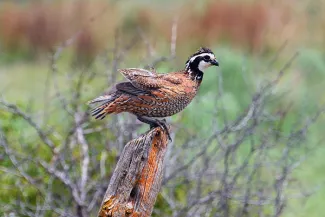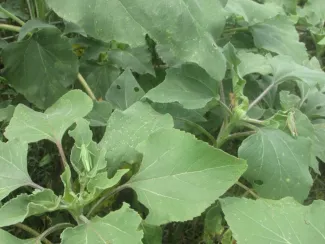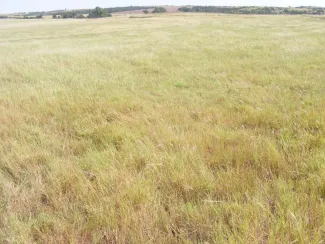"Where have my quail gone?" I hear this very question working with landowners and managers every year. After generations of sportsmen have enjoyed quail on a property, it seems like all of a sudden the birds just disappeared. This realization can be very troubling for landowners, hunters, and other wildlife enthusiasts. Oftentimes, the absence of birds like northern bobwhite on a property can be traced back to how the property has been managed; small changes have been made over the years that have added up to equal poor habitat. It’s important to ask yourself, “Is my property providing the things that quail need?”
Quail are a ‘shrub-obligate’ species, meaning that they need shrub cover to be able to survive. Shrub thickets of sand plum and sumac provide protection from Oklahoma’s extreme weather as well as predators and properties where shrubs have been slowly eradicated to make room for easier haying or grazing may not be meeting these needs.

Throughout the spring and summer, quail are focused on eating nutrient rich insects. In the fall and winter, they rely heavily on “weed” seeds. Management practices over time have become more and more reliant on the use of herbicides and pesticides and, while these can be very beneficial tools, they are over-used in many circumstances. If we are applying these chemicals across our entire fields and properties to “kill off those pesky weeds” or “reduce how many bugs are eating our crops” we are actually removing all the food sources that quail rely on. Using more targeted or direct approaches with chemicals rather than large scale applications could help to ensure that we’re providing the food quail will need to carry them through the year.

"Weeds" and insects are important components of good quail habitat. How many grasshoppers can you find in this photograph? (Kyle Johnson)
Over the years, we have seen many recommendations on “improving” land and history has shown us that time after time these ideas often lead to unintended consequences. Eastern red cedar, sericea lespedeza, and even Johnsongrass were recommended to plant by many agencies in our past as wind breaks and “premier cattle forage,” only to realize later that these plants would grow to take over much of our native prairies. Bermudagrass, old world bluestem and fescue pastures are now quite common across our state, but from a quail’s perspective these fields offer very little when it comes to their needs.

Pure grasslands, especially monoculture pastures of old world bluestem, bermudagrass and fescue offer very little of what quail need to survive and persist. (Kyle Johnson)
Another important part of the equation is fire. Oklahoma’s landscape evolved with fire, as did all of our native plants and wildlife. Most areas of our state were burned every 3-7 years, and this routine presence of fire helped to prevent the native grasses from becoming too thick. Imagine a cotton ball with legs trying to run through your yard or your field; in most instances it would probably have a difficult time because of the woven thatch of grasses. Using prescribed fire to safely manage your property can help remove that thatch and balance your forbs and grasses, making it easier for that cotton ball or quail chick to chase down its first meal. Fire, too, was and still is the key to maintaining the open, lush forest communities that once supported quail. Today, the lack of fire has allowed closed-canopy forests to proliferate across the state and dense forests don’t provide what quail need.
So where do we go from here? While habitat management can seem like a daunting task, it’s a lot like eating an elephant; you just have to take it one bite at a time! The Wildlife Department is here to help as well. Reach out to our regional private lands staff or myself for technical assistance where we can help you develop a plan to improve your wildlife habitat.